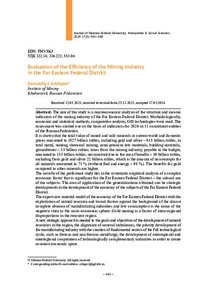Показать сокращенную информацию
Оценка эффективности горнодобывающей отрасли в Дальневосточном федеральном округе
| Автор | Архипов, Г. И. | ru_RU |
| Автор | Arkhipov, Gennadiy I. | en |
| Дата внесения | 2024-03-15T02:14:17Z | |
| Дата, когда ресурс стал доступен | 2024-03-15T02:14:17Z | |
| Дата публикации | 2024-03 | |
| URI (для ссылок/цитирований) | https://elib.sfu-kras.ru/handle/2311/152703 | |
| Аннотация | Целью исследования является макроэкономический анализ структуры и показателей доходов горнодобывающей отрасли ДФО. В методическом плане использовались экономико- статистические приемы, сравнительный анализ, ГИС-технологии. Оценка проводилась на основе показателей 2020 г. 11 субъектов РФ. Показано, что общая стоимость добытых и реализованных полезных ископаемых по сложившимся мировым и внутренним ценам составила 1827 млрд руб., в том числе золота и серебра – 915 млрд руб., совокупно металлического, горнорудного, горнохимического, камнесамоцветного сырья, стройматериалов, подземных вод – 53 млрд руб.; налоги от отрасли ДПИ, подлежавшие уплате в бюджет, составили 155 млрд руб., не поступившие в связи с применением льгот – 30 млрд руб., в том числе за счет золота и серебра 22 млрд руб., что в сумме не поступления за все полезные ископаемые составило – 73 % (без топливно-энергетических – 98 %). Льготы для золота по сравнению с другими полезными ископаемыми выше. Новизна выполненного исследования заключается в системном эмпирическом анализе значимого для ДФО сложного экономического фактора – недропользования субъектов. Областью применения полученных обобщений могут стать стратегические разработки развития экономики субъектов ДФО. Экспортно-сырьевая модель экономики ДФО с эксплуатацией природно-ресурсных и транзитных факторов на фоне почти полного отсутствия обрабатывающих производств и низкого потребления является причиной негативного состояния в социально- экономической сфере. Золотодобыча является фактором внутрирегиональных диспропорций в ресурсном регионе. Необходим новый стратегический подход к целям и задачам освоения минеральных ресурсов в регионе, выравнивание отраслевых дисбалансов, приоритетное развитие обрабатывающей промышленности с созданием фундаментальных отраслей полного технологического цикла, таких как черная и цветная металлургия, развитие внутрирегиональной и межрегиональной кооперации технологически взаимодополняющих производств с целью создания общего экономического пространства | ru_RU |
| Аннотация | The aim of the study is a macroeconomic analysis of the structure and income indicators of the mining industry of the Far Eastern Federal District. Methodologically, economic and statistical methods, comparative analysis, GIS technologies were used. The assessment was carried out on the basis of indicators for 2020 in 11 constituent entities of the Russian Federation. It is shown that the total value of mined and sold minerals at current world and domestic prices amounted to 1827 billion rubles, including gold and silver – 915 billion rubles, in total metal, mining, chemical mining, semi-precious raw materials, building materials, groundwater – 53 billion rubles; taxes from the mining industry, payable to the budget, amounted to 155 billion rubles, not received due to the use of benefits – 30 billion rubles, including from gold and silver 22 billion rubles, which is the amount of non-receipts for all minerals amounted to 73 % (without fuel and energy – 98 %). The benefits for gold compared to other minerals are higher. The novelty of the performed study lies in the systematic empirical analysis of a complex economic factor that is significant for the Far Eastern Federal District – the subsoil use of the subjects. The area of application of the generalizations obtained can be strategic developments in the development of the economy of the subjects of the Far Eastern Federal District. The export-raw material model of the economy of the Far Eastern Federal District with the exploitation of natural resource and transit factors against the background of the almost complete absence of manufacturing industries and low consumption is the cause of the negative state in the socio- economic sphere. Gold mining is a factor of intra- regional disproportions in the resource region. A new strategic approach is needed to the goals and objectives of the development of mineral resources in the region, the alignment of sectoral imbalances, the priority development of the manufacturing industry with the creation of fundamental sectors of the full technological cycle, such as ferrous and non-ferrous metallurgy, the development of intraregional and interregional cooperation of technologically complementary industries in order to create common economic space | en |
| Язык | ru | ru_RU |
| Издатель | Journal of Siberian Federal University. Сибирский федеральный университет | en |
| Тема | экономика региона | ru_RU |
| Тема | недропользование | ru_RU |
| Тема | месторождения | ru_RU |
| Тема | запасы | ru_RU |
| Тема | добыча | ru_RU |
| Тема | золото | ru_RU |
| Тема | налоги | ru_RU |
| Тема | экспорт | ru_RU |
| Тема | отраслевой подход | ru_RU |
| Тема | Дальневосточный федеральный округ | ru_RU |
| Тема | regional economy | en |
| Тема | subsoil use | en |
| Тема | deposits | en |
| Тема | reserves | en |
| Тема | production | en |
| Тема | gold | en |
| Тема | taxes | en |
| Тема | exports | en |
| Тема | sectoral approach | en |
| Тема | Far Eastern Federal District | en |
| Название | Оценка эффективности горнодобывающей отрасли в Дальневосточном федеральном округе | ru_RU |
| Альтернативное название | Evaluation of the Efficiency of the Mining Industry in the Far Eastern Federal District | en |
| Тип | Journal Article | ru_RU |
| Контакты автора | Архипов, Г. И.: Институт горного дела Российская Федерация, Хабаровск | ru_RU |
| Контакты автора | Arkhipov, Gennadiy I. : Institute of Mining Khabarovsk, Russian Federation; arhipov@igd.khv.ru | en |
| Страницы | 465–480 | ru_RU |
| Журнал | Журнал Сибирского федерального университета. 2024 17(3). Journal of Siberian Federal University.Humanities & Social Sciences 2024 17(3) | en |
| EDN | FMVSKJ |

